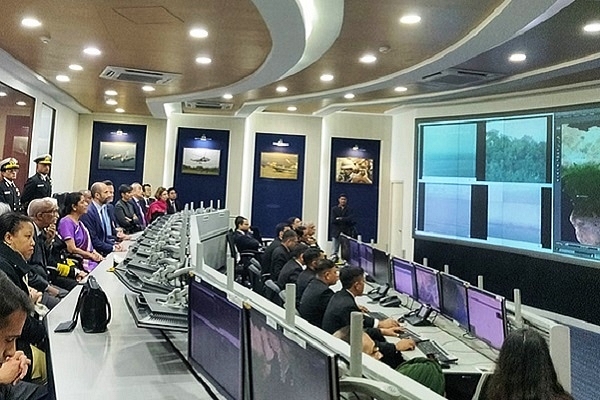
Explained: India Navy’s Information Fusion Centre For Indian Ocean Region, Why It Is Critical To India’s Interests
The Information Fusion Centre for the Indian Ocean Region (IFC-IOR), an initiative of the Indian Navy and supported by the Government of India launched in December 2018, has started functioning.
The IFC-IOR has been established at Gurugram along with the Information Management and Analysis Centre, jointly administered by the Indian Navy and Indian Coast Guard.
Recently, at the Goa Maritime Conclave (GMC), National Security Adviser Ajit Doval asked the countries in the IOR to use of the facility to track movement of vessels on the high seas.
“The centre is actively interacting with the maritime community and has already built linkages with 18 countries and 15 multinational/maritime security centres,” an official was quoted as saying by the The Hindu.
Reportedly, Maldives, Mauritius, Sri Lanka and Seychelles have already joined the initiative while talks are on with Bangladesh and Thailand.
Why IFC-IOR?
The Indian Ocean region is extremely important for the surrounding countries, not just for the commercial and economic reasons, but also for national security purposes. By its very nature of being porous and expansive, the maritime domain is hard to monitor and regulate.
The ocean is susceptible to threats such as maritime terrorism, piracy, human and contraband trafficking, illegal and unregulated fishing, arms running and poaching. To effectively control these, collaborative efforts between countries are required.
An important aspect of this collaboration is information sharing.
Currently, the exchange of information is done using telephone calls, faxes, emails and video conferencing over Internet. This is set to change with the IFC-IOR, which will host liaison officers from partner countries.
The IFC-IOR will act as a dedicated centre for undertaking collation, fusion and dissemination of the data being exchanged with all partners. The centre has been established to address the twin requirements of situational awareness and law enforcement.
While India already has bilateral information sharing arrangements with different countries, and is constantly upgrading its capabilities in this regard, the dedicated centre marks a new era of using high-tech approach for detection and neutralisation of maritime security threats in the region.
The Indian Navy website states following functions of the centre:
- Confidence and capacity building amongst partner nations, thereby ensuring swift and accurate exchange of information pertaining to maritime security.
- Maintaining extensive and continuous linkages to ensure comprehensive maritime domain awareness of the region thereby achieving transparency of maritime environment.
- Use of high tech including state of the art methods and analytic tools to undertake traffic analysis thereby ensuring that any emerging threats and trends are predicted in time.
Importance of Indian Ocean Region
Over 75 per cent of the world’s maritime trade and 50 per cent of daily global oil consumption passes through the IOR, It is, therefore, vital to world trade and the economic prosperity of many nations. A large percentage of global population resides in the Indian Ocean littoral states.
The number one threat for India is the expanding Chinese footprint in the Indian Ocean, a strategy dubbed as ‘string of pearls’ tightening around India’s neck.
On its part, India favours an open, rule-based and multilateral order governing the ocean. This goal is reflected in India’s leadership of several organisations like Indian Ocean Naval Symposium, Indian Ocean.
SAGAR (security and growth for all in the region), a slogan given by Prime Minister Modi has become the leitmotif of India’s maritime diplomacy. It has taken several steps to address the needs of other littorals with regards to capacity to monitor and respond to maritime challenges.
At home, India is also mulling strengthening the Indian Navy and increasing its footprint across the Ocean in mission based deployment.
While China is far ahead of India in its economic prowess and infrastructure offerings, India possesses the soft power of a democracy sensitive to the needs of the local population. On the other hand, China is seen as a bully who expects the beneficiary states to submit to its wishes.
While India is currently reluctant on forming direct security coalitions like QUAD (India, Australia, Japan, United States) to hedge against China, partially due to its historical distrust of US and partially to not aggravate China, it may need to collaborate with big powers in the future depending on China’s course of action.
India can bring together its bilateral cooperation with European countries into a comprehensive strategic framework for maritime intelligence in the region, logistical support arrangements and sharing naval infrastructure.
The European countries not only have military presence, security arrangements and a network of political influence in the region going back to the colonial era, but also a great stake in maintaining a rule based global order, liberal trading system and freedom of navigation in the Indian Ocean.
As India’s cooperation with Russia in the Far East deepens, latter will have a stronger stake in protecting the freedom of navigation in the region.
In the long run, India should aim to become a net security provider in the region. This will require India to enhance own strengths first, and then expand partnerships to fill the voids. India should have nothing less than a leadership role in guiding the foreign powers in its backyard, rather than being an instrument to control China.